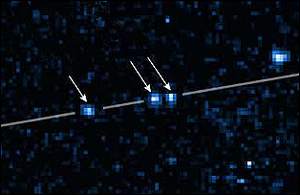
RX J185635-3754 is 200 light-years away

RX J185635-3754 is 200 light-years away
November 11, 2000 - BBC
Astronomers have identified a runaway neutron star that is hurtling in our direction at more than 100 times the speed of a supersonic jet.
Neutron stars are small, extremely dense, rapidly rotating spheres of neutrons that are created when some of the biggest stars in the Universe explode at the end of their fuel-burning lives.
This object, designated RX J185635-3754, is smaller than the Isle of Wight but 10 trillion times denser than steel. Astronomers say it would have been seen to blow up in the night sky by our distant ancestors in one million BC.
Now just 200 light-years away in the southern constellation Corona Australis, the neutron star will pass the Earth at a more than safe distance of 170 light-years in about 300,000 years. A light-year is the about 10 trillion km (6 trillion miles).
Lone star
RX J185635-3754 is the closest known neutron star - its distance has been well measured by the Hubble Space Telescope. Astronomers will now study the object's physical properties, such as size, brightness and age, and use it to test their theories about neutron stars.
"The scientific importance of this object lies in the fact that the neutron star is isolated," said Frederick Walter of the State University of New York.
"It appears to be hot, not because it is accreting hydrogen gas as it moves through space but because it is still young and cooling off. Since we know its approximate age, we can test how fast neutron stars cool off."
"Because this is the closest and brightest of the few known isolated neutron stars, it is the easiest to study and is an excellent test-bed for nuclear astrophysical theories."
The neutron star's trajectory was caught in three Hubble images taken in 1996 and 1999. The three images show it moving across the sky.
In 5,400 years, RX J185635-3754 travels an apparent angular distance across the sky equal to the diameter of the Moon. Although this apparent motion may seem slow, it is actually one of the fastest moving stars in the sky.
Binary system
This neutron star may be moving away from a grouping of young stars in the constellation Scorpius.
About one million years ago, a massive star in a binary system exploded as a supernova, releasing its companion star, an ultra-hot, blue star now known as Zeta Ophiuchus. This is also moving away from the region.
One million years ago, the neutron star and Zeta Ophiuchus would have been in about the same location in space. This makes astronomers think the neutron star may be remnant of the original binary companion to Zeta Ophiuchus which exploded.
The Hubble image at the top of the page is the sum of three images showing the motion of the star across the sky.
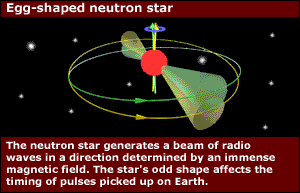
August 3, 2000 - BBC
Astronomers have found a super-dense egg-shaped star spinning in space.
The pulsar is the size of a city, yet weighs more than a million times that of the Earth. It spins and pulses nearly three times a second.
A detailed observation of its radio pulses suggests that it is not absolutely spherical but slightly flattened.
Because the star is made of material normally found at the centre of atoms, the observations should help scientists understand how matter behaves under extreme conditions.
Slightly squashed
The discovery of the pulsar was made using the world famous Lovell Telescope at the Jodrell Bank Observatory, UK.
Pulsars are rapidly spinning neutron stars. They are typically not much more 10 km (6 miles) in diameter, but still weigh more than our own sun.
A pulsar produces beams of radio waves that sweep like a lighthouse across the Universe. When a beam crosses the Earth, a pulse of radiation is detected.
Jodrell Bank astronomers Ingrid Stairs, Andrew Lyne and Setnam Shemar studied 13 years of data from the pulsar PSR B1828-11. They discovered that the star wobbles like a gyroscope with a period of about 1,000 days, as well as flashing 2.5 times a second.
The wobble causes the pulse to change its shape, and makes the time between pulses vary.
In an article in the journal Nature, the astronomers say that the neutron star is not perfectly spherical but slightly squashed.
Neutron superfluid
The deformation is great. Dr Stairs said: "This star departs from being a perfect sphere by only 0.1 mm in 20 km. To the same scale on the Earth this would mean that no mountain could be higher than 3 cm."
The surprising aspect to the discovery is not the small size of the wobble but the fact that the wobble is seen at all.
The interior of a pulsar is made up largely of a neutron superfluid, with a solid crust.
Current theories predict that the interaction between the superfluid and the crust should cause any precession to die out extremely quickly.
"But this pulsar is one hundred thousand years old, and it's still wobbling," said Professor Andrew Lyne.
"We really don't understand how this precession can be happening, and theorists are going to have to do some work to explain it."
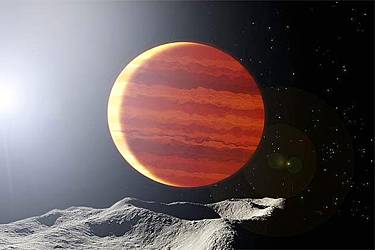
Brown dwarfs start out in a dull shine, resembling the coolest of stars, but their brightness peters out quickly, and they fade away into cool, dark objects resembling Jupiter in size and appearance, but tens of times more dense.
May 12, 2000 - AP
A sweeping survey of the night sky has detected three new brown dwarfs that fill in the blanks in the sad history of these cosmic rejects.
In the celestial pecking order, brown dwarfs fill a hazy space between stars and planets.
"They're like starlets in Hollywood that never really made it," said California Institute of Technology brown-dwarf expert Davy Kirkpatrick.
The new brown dwarfs, captured in images taken in February by the United Kingdom's Infrared Telescope (UKIRT) in Hawaii and the Sloan Digital Sky Survey telescope in New Mexico, represent the transition of these stellar objects from "failed stars" to "pseudo-planets."
"They fill a 'missing link' in our knowledge of how these objects evolve over time," said UKIRT astronomer Sandy Leggett. She and her colleagues report the discovery in an upcoming issue of the Astrophysical Journal.
Born in the same celestial nurseries as stars, brown dwarfs lack the mass needed to make it as true stars. They can't generate enough pressure in their core to set off nuclear fusion, which is how real stars shine for billions of years.
Instead, powered by energy leftover from their birth, brown dwarfs start life in a dull shine, resembling the coolest of stars. But their brightness peters out quickly. They fade away into cool, dark objects resembling Jupiter in size and appearance, though tens of times as dense.
Hundreds of young, hotter brown dwarfs are known to exist in the sun's neighborhood, and the first older brown dwarf was found in 1995 orbiting a nearby star.
Astronomers have long suspected the existence of "transitional" brown dwarfs filling the gap between the hotter dwarfs and the colder dwarfs, but finding them proved difficult because of their faintness. To detect them, the researchers analyzed infrared spectra from promising candidates identified by the Sloan survey.
Tell-tale patterns in the light indicated the presence of both carbon monoxide, which dominates younger, star-like dwarfs, and methane, found mainly on the older planet-like ones. The presence of both chemicals suggested these new dwarfs were in transition from one state to the other.
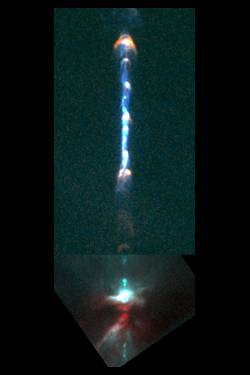
New images from the Hubble telescope reveal evidence of a cosmic fight between a trio of stars that occurred a few thousand years ago. This composite image shows two gas jets blasted into space from the pair of stars remaining after the duel.
March 19, 2000 - AP
New Hubble Space Telescope images reveal an intimate celestial encounter between a trio of newborn stars located 1,400 light-years, or 8.1 trillion miles, from Earth.
Infrared Hubble images were combined with ground-based radio observations to reveal the three young stars located near the torus, or donut, of gas and dust from which they formed. Two of the stars are closely embracing each other, while the other star has broken off from the pair.
Surprisingly, the stars are not located at the center of the torus, where newborn stars are usually found. The pair is set to one side, below the donut, and the third star is off to the other side and above the torus.
From the images and computer simulations, scientists believe that a "gravitational brawl" occurred between the stars a few thousand years ago. After the fight, one star was ejected, and the remaining binary pair flew off in the opposite direction.
The two stars in the binary pair are so close together -- about five billion miles -- that Hubble can only see them as one object. New Mexico's Very Large Array radio observations showed two separate pairs of stellar jets being emitted from the object at right angles, implying that the "object" Hubble detected was really two distinct stars.
Scientists believe the binary pair are also the point of origin of two streams of gas, 12 light-years, or 69.6 billion miles long, that were sent into space by one of the stars.
"It's mind-boggling that small stars like this can have such a profound influence on their environment," says Bo Reipurth of the University of Colorado, head of the Hubble research team.
Scientists hope these new observations can help them understand how the masses of stars are determined. Since the "gravitational brawl" ejected the stars from the stellar donut, they are no longer able to use the supply of gas and dust in the torus and are unable to grow.
After they leave a torus, stars have a small "inner gas disk" for fueling gaseous outbursts. The new stars' jet activity should wane as the disks are depleted.
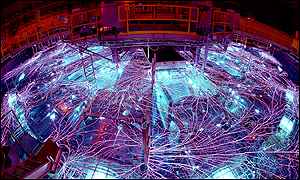
The Z machine is the most powerful X-ray generator on Earth
November 11, 1999 - BBC
Laboratory physicists have simulated some of the effects found around one of the strangest and most dangerous objects in the known universe.
In an inconspicuous building in the desert of New Mexico, a machine has been creating temperatures that rival that found at the centre of the Sun. It is helping physicists discover what happens to matter when falls into in the grip of black holes and neutron stars.
The experiments are taking place at the Sandia National Laboratories' using the so-called Z machine - the most powerful X-ray generator on Earth.
Exploding stars
Some space-borne observatories are sensitive to X-rays, high energy radiation from the hot and violent parts of the cosmos; the surfaces of active stars, the remnants of exploded stars and from matter being super-heated as it is being sucked into a black hole or onto the surface of a super-dense object called a neutron star.
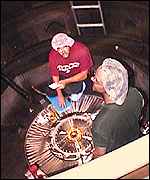 Engineers prepare Z
Engineers prepare ZWhen these titanic events occur astronomers using observatories like the Chandra X-ray observatory, look for the presence of iron because its X-ray signature tells them what conditions are like in these violent events.
Creating a neutron star or black hole on Earth for scientists to study would be something of a problem. Even it were technically possible it would destroy our planet.
But Mark Foord, one of the project leaders, says because "neutron stars and black holes radiate X-rays similar in effect to those emanated by Z, we realised we have a chance to test astrophysical theoretical models that have never been tested experimentally."
The results will further human understanding of black holes and neutron stars.
Super hot plasma
Colleague Jim Bailey adds, "We're looking at the atomic physics of ionised iron so that they can be compared with theoretical calculations."
"We have a collaboration with four or five groups around the world whose main job is to analyse data from Chandra," says Dr Foord. "They have made some predictions that we're going to compare to our data."
The experiments involve placing thin slivers of iron at the heart of the Z-machine where it is exposed to temperatures of more than one million degrees for a few billionths of a second. The electrons orbiting the atomic nucleii are stripped away and the iron becomes a super hot plasma radiating X-rays.
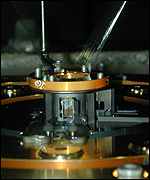
The iron is vaporized in this chamber
"Iron has thousands of spectral lines," says Dr Foord. "We know their signatures but they differ in intensity depending on which electrons, or how many, have been stripped away in the ionising heat of a neutron star. Calculating these relative intensities is uncertain."
"This makes it difficult to predict how highly ionised iron is, or should be, in other star systems. If we can measure in the lab what the actual figures are, we learn how to interpret our data from the stars."
"Our first two shots were in late October and we are now analysing the data," says Dr Foord. "It appears that we were successful at producing highly ionised iron and were able to obtain an accurate measurement of the radiation produced from the Z."
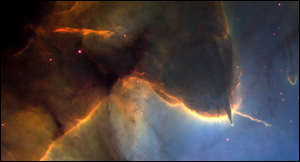
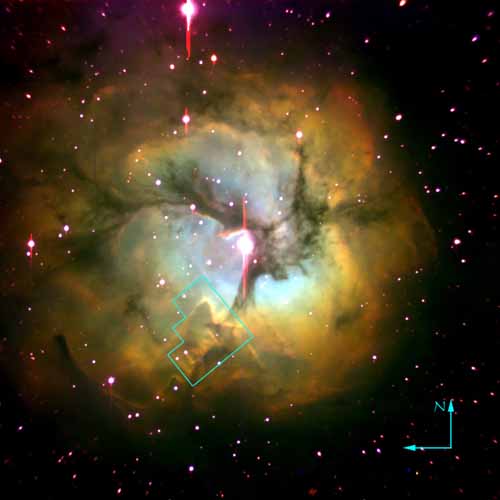
November 10, 1999 - BBC
This Hubble Space Telescope image of the Trifid Nebula shows a stellar nursery being torn apart by radiation from a nearby, massive star.
The picture also provides a glimpse of embryonic stars that are forming within the ill-fated cloud of dust and gas. These are destined to be eaten away by the radiation from their massive neighbour.
The Hubble image shows a small part of the Trifid nebula, a dense cloud of dust and gas about eight light-years away from the nebula's central star. The star is not in Hubble's view.
Rising star
A thin and wispy stellar jet protrudes from the head of the dense cloud and extends almost a light year into the cloud. The jet's source is a very young star that lies buried within the cloud.
Within the next 10,000 years the glare of the central, massive star will eat away at the nebula and destroy the forming star.
Another nearby star may have already faced this fate.
The Hubble picture shows a "stalk" pointing from the head of the dense cloud directly toward the star that powers the Trifid.
It is thought that the stalk has survived because at its tip there is a knot of gas that is dense enough to resist being eaten away by the powerful radiation.
The images were taken on 8 September 1997 through filters that isolate emission from hydrogen atoms, ionised sulphur atoms, and ionised oxygen atoms.
The images were combined in a single colour composite picture. While the resulting picture is not true colour, it is suggestive of what a human eye might see.
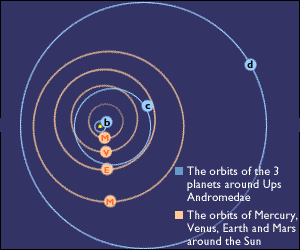
September 29, 1999 - BBC Online
For the first time astronomers have seen a star move in the sky under the influence of the gravity of a planetary companion.
The star is called Upsilon Andromedae, it is about 45 light years away and remarkably like our Sun. It hit the headlines earlier this year as being the first star, other than our Sun, to be known to have more than one planet orbiting it. It has three.
In recent years about 20 "exoplanets" have been detected circling other stars using the so-called radial velocity technique.
As a planet orbits its parent star, it causes it to wobble slightly. This motion can be detected using the most sensitive instruments as a shift in the star's spectrum. It appears as a regular motion first towards and then away from the Earth.
Star catalogue
The latest observations are the first time that a planet has been detected by observing the motion of the star from side to side on the sky.
The observations were made by the Hipparcos satellite launched in 1989. It has compiled one of the most accurate star catalogues ever made, charting the positions of 100,000 stars more accurately then ever before.
Previous observations showed that the outermost planet of Upsilon Andromedae circles the star in 1,269 days. A close examination of the Hipparcos data showed that the star wobbles from side to side at this periodicity.
The new observations allow the mass of the planet to be determined with unprecedented accuracy. It turns out to be about 10 Jupiter masses, with an uncertainty of 5 Jupiter masses.
This means that the object is almost certainly a proper planet and not a small star that never grew quite big enough to generate enough energy to shine.
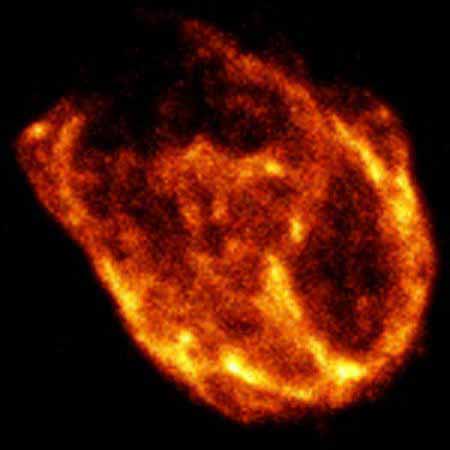
September 11, 1999 - Reuters - Washington
The Chandra X-ray Observatory, which is taking a new look at the universe, snapped images of what is left of an exploded star in a nearby galaxy, astronomers reported Friday.
The tatters of the exploded star -- known as a supernova -- are shown as a red, yellow and black blob in images visible online at http://chandra.harvard.edu/photo/0050.
The supernova, known as N132D, is in the Large Magellanic Cloud, a companion galaxy to the Milky Way some 180,000 light-years from Earth. A light-year is the distance light travels in a year, about 6 trillion miles (10 trillion km).
Massive stars explode about once every 50 years or so, and one such supernova explosion perhaps five billion years ago probably led to the formation of the solar system and furnished chemicals necessary for life on Earth.
The images were made by Chandra's High Resolution Camera.
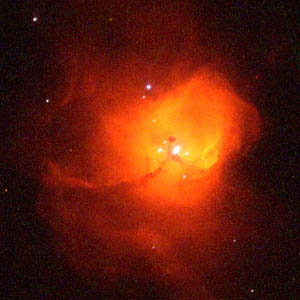
July 23, 1998 -AP
Massive baby stars, nestled in a cloud of glowing gases and shining as bright as 300,000 suns, are at the center of a galactic "family portrait" snapped by the Hubble Space Telescope.
The image taken by the orbiting Hubbletelescope shows 50 stars packed tightly at the gas-cloud's heart, and could indicate that such massive stars form in groups. The place where the stars are clustered used to be known to astronomers simply as "The Blob" because its features were indistinguishable in ground-based telescopes.
The snapshot of the celestial maternity ward could provide clues to how ancient, super-massive stars formed, the Space Telescope Science Institute said in a statement.
Located 200,000 light-years away in a small, irregular galaxy known as the 'Small Magellanic Cloud', the infant stars are surrounded in the image by the heavenly fireworks that accompanied their birth. A light-year is the d istance light travels in a year, about 6 trillion miles. This kind of fiery display was much more common billions of years ago, when the universe was young and most stars were formed, the scientists' statement said.
These star babies may be a throw-back to the kinds of massive stars created long ago, which were made exclusively of primordial elements hydrogen and helium produced in the theoretical 'Big Bang'. Stars in the 'Small Magellanic Cloud' are similar to these primitive stars in that they lack heavier elements, the scientists said.
ALPHABETICAL INDEX OF ALL FILES